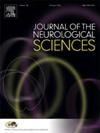白质病变和亚临床脑缺血对心脏瓣膜术后认知训练结果的影响:一项随机临床试验
IF 3.2
3区 医学
Q1 CLINICAL NEUROLOGY
引用次数: 0
摘要
背景:白质病变和亚临床脑缺血(SCI)被认为是心脏手术后认知能力下降(POCD)的危险因素。本报告旨在探讨脑损伤对术后认知训练结果的影响。方法:在一项随机、照例治疗的对照试验中,参加了计划择期心脏瓣膜手术的老年患者。术后认知训练包括纸笔练习。术前、康复出院时(训练后立即)和3个月随访时评估神经心理学参数。此外,还评估了抑郁和焦虑(HADS)以及与健康相关的生活质量(SF-36)。采用磁共振成像识别脑病变(训练组:n = 18;对照组:n = 21)。具体而言,使用t2加权/FLAIR序列评估心室周围白质病变(PVWML)和深部白质病变(DWML),并根据Fazekas量表进行分类。采用弥散加权成像对脊髓损伤进行体积分析。为了统计控制脑损伤对训练结果的影响,我们采用协方差分析。结果:三个月随访结果:在控制SCI对训练结果的独立性后,整体认知(p = 0.022)和SF-36心理成分总结(p = 0.003)的影响是明显的。考虑到PVWML对训练结果的影响,训练后的参与者在抑郁(p = 0.046)和SF-36心理成分总结(p = 0.013)方面表现出更好的价值。在PVWML患者的亚组分析中,训练组表现出更好的语言表现(p = 0.037)。调整DWML后,SF-36心理成分摘要的训练效果显著(p = 0.013)。结论:脑病变患者可从心脏手术后的认知训练中获益。本文章由计算机程序翻译,如有差异,请以英文原文为准。
The impact of white matter lesions and subclinical cerebral ischemia on postoperative cognitive training outcomes after heart valve surgery: A randomized clinical trial
Background
White matter lesions and subclinical cerebral ischemia (SCI) are described as risk factors for postoperative cognitive decline (POCD) following cardiac surgery. This report aims to investigate the effect of brain lesions on postoperative cognitive training outcomes.
Methods
In a randomized, treatment-as-usual controlled trial, elderly patients scheduled for elective heart valve surgery participated. The postoperative cognitive training comprised paper-and-pencil exercises. Neuropsychological parameters were assessed preoperatively, at discharge from rehabilitation (immediately post-training), and at the 3-month follow-up. In addition, depression and anxiety (HADS) as well as health-related quality of life (SF-36) were evaluated. Brain lesions were identified using magnetic resonance imaging (training group: n = 18; control group: n = 21). Specifically, periventricular white matter lesions (PVWML) and deep white matter lesions (DWML) were assessed using T2-weighted/FLAIR sequences and categorized according to Fazekas scale. Volumetric analysis of SCI was conducted using diffusion-weighted imaging. To statistically control the impact of brain lesions on training outcomes, we employed analysis of covariance.
Results
Three-month follow-up results: When controlling for the independence of SCI on training outcomes, effects were evident for global cognition (p = 0.022) and SF-36 mental component summary (p = 0.003). Considering the impact of PVWML on training outcomes, trained participants showed better values in depression (p = 0.046) and SF-36 mental component summary (p = 0.013). In a subgroup analysis for patients with PVWML the training group demonstrated superior performance for language (p = 0.037). After adjusting for DWML, training effects were noticeable in the SF-36 mental component summary (p = 0.013).
Conclusion
Patients with brain lesions may benefit from cognitive training after cardiac surgery.
求助全文
通过发布文献求助,成功后即可免费获取论文全文。
去求助
来源期刊

Journal of the Neurological Sciences
医学-临床神经学
CiteScore
7.60
自引率
2.30%
发文量
313
审稿时长
22 days
期刊介绍:
The Journal of the Neurological Sciences provides a medium for the prompt publication of original articles in neurology and neuroscience from around the world. JNS places special emphasis on articles that: 1) provide guidance to clinicians around the world (Best Practices, Global Neurology); 2) report cutting-edge science related to neurology (Basic and Translational Sciences); 3) educate readers about relevant and practical clinical outcomes in neurology (Outcomes Research); and 4) summarize or editorialize the current state of the literature (Reviews, Commentaries, and Editorials).
JNS accepts most types of manuscripts for consideration including original research papers, short communications, reviews, book reviews, letters to the Editor, opinions and editorials. Topics considered will be from neurology-related fields that are of interest to practicing physicians around the world. Examples include neuromuscular diseases, demyelination, atrophies, dementia, neoplasms, infections, epilepsies, disturbances of consciousness, stroke and cerebral circulation, growth and development, plasticity and intermediary metabolism.
 求助内容:
求助内容: 应助结果提醒方式:
应助结果提醒方式:


